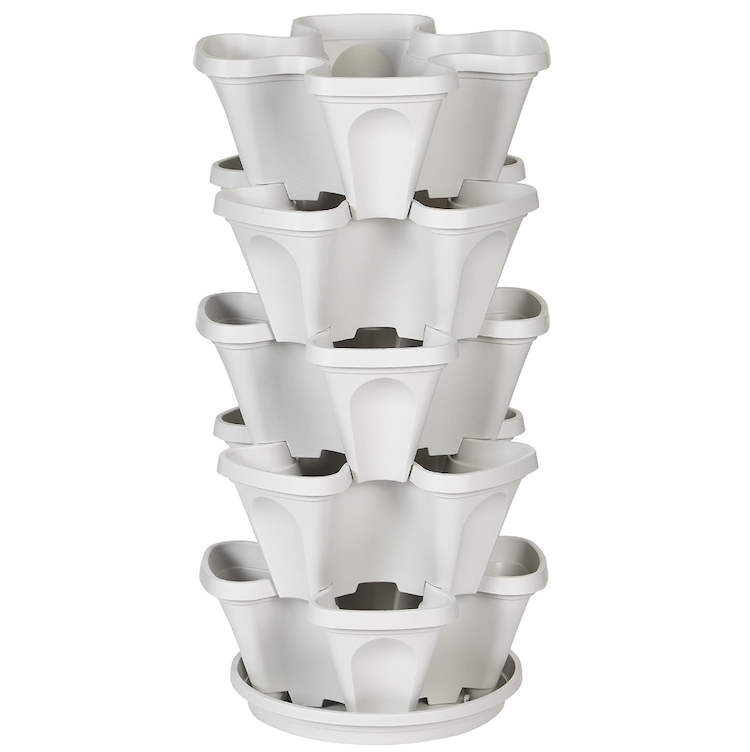9 Gardening Tips To Start Planting In Any Size Space
This page may contain affiliate links. As an Amazon affiliate, we may earn a small commission for any purchases made through these links. Click here for the disclosure statement.
For many people, the shift from winter’s cold weather into spring’s showers and summer’s sun means gardening season is here. Although most people associate gardens with raised beds and rows of produce in the backyard, gardens can grow and flourish in any space, from your balcony to your countertops.
The Benefits of Starting a Garden
There’s nothing quite like enjoying a delicious meal made with the fruits, vegetables, and herbs you grew in your own garden. Not only does growing your own food help you save money, but it also provides a better flavor and more nutrients than the produce you purchase from the grocery store. Whether you’re planting on your balcony, in containers, or inside on your countertop, when you’re gardening, you’re in control of what goes into your soil—minerals, compost, and nutrients—all of which help to support your plants, and, in turn, provide a more nutritious harvest for your table.
Are you ready to build your own garden? Here are nine gardening tips to help you get started no matter what size space you have to plant.
Price Reference (average price):
$ | Under $25
$$ | Between $25-$50
$$$ | More than $50
How To Plant a Balcony Garden
Living in a space with only balcony access doesn't mean that you have to give up growing fresh produce. With these gardening tips, you can enjoy a successful harvest right on your own patio.
Assess Your Lighting
Before you begin planting a garden, the first thing you need to consider is lighting. Most plants, including tomatoes, berries, melons, and squash thrive in full sun—meaning they get six to eight hours of direct sunlight each day. However, several varieties can thrive in partial sun/shade—four to six hours of direct sunlight—and full shade. If your balcony receives partial sun and shade, then you can easily grow peas, onions, cauliflower, carrots, and even beets without having to add supplemental lighting.
If you find that your balcony doesn’t offer enough lighting to grow healthy varieties of your desired plants, opt for a grow light. Grow lights are essentially a substitute for sunlight, allowing you to emulate the process of photosynthesis without the sun. This not only supports your plants' growth during your typical gardening season, but grow lights can also help you keep your favorite fruits, vegetables, herbs, and other plants healthy year-round.
Image: Amazon
Budget-Friendly
LED Full Spectrum Grow Light
Fecida
Price: $$
These lights feature full-spectrum technology that helps your plants grow through each stage from seed to fruiting.
Why We Love It: This set of grow lights is adjustable to fit your gardening space!
Image: Amazon
Splurge-Worthy
Solar-Powered Grow Light
BestDrop
Price: $$$
If you want to reduce your energy bill, consider a solar-powered grow light. Charged by the sun, this grow light includes a small solar panel that can be attached to the side of your balcony.
Why We Love It: It also has a full-spectrum sunlight lamp with adjustable brightness and a remote control that offers automatic or manual control settings.
Get Creative With Your Space
Some plants love to take up what precious space you have, but remember, you’re not limited to floor space when it comes to gardening. Before you begin your seed and plant shopping, lay out your garden space and research which varieties will be best for you. Tomatoes, for example, love to take up space; however, you can find bush varieties and miniature-sized plants that are perfect for small spaces.
Image: Amazon
Budget-Friendly
Garden Trellis & Planter
Green Mount
Price: $$
If floor space is limited on your balcony, opt for vegetables that grow along your walls. Whether you have a trellis in your garden bed or a railing around your balcony, cucumbers, peas, and pole beans love to grow and climb vertically.
Why We Love It: Planting varieties that are supported by this trellis also offer eye-catching foliage that’s almost too beautiful to eat.
Image: Amazon
Splurge-Worthy
5 Tier Stackable Planter
Mr. Stacky
Price: $$
With a patented flow through design, this standing planter provides excellent drainage.
Why We Love It: It also saves space on your balcony while giving you plenty of room to plant vegetables and herbs.
How To Plant a Container Garden
Whether you have a small outdoor space or are seeking flexibility to move your plants throughout your space, container gardening is a budget-friendly and easy-to-maintain option.
Container gardening offers versatility, both in your space and in the variety of produce you can plant. With the proper knowledge and care, any plant can grow healthily in containers. Before you begin planting, consider these tips to create a successful container garden.
Research The Plants
Not all containers are the right fit for your plants. As a general rule of thumb, most experts recommend staying away from pots that are small in size than 12 inches. The more soil the planter can hold, the more moisture your plant will retain, which will help keep your leafy buds happy and healthy.
When choosing your plants and their homes, consider their root systems. Each plant’s root system is different—while some plants, like herbs, can live happily in a pot as small as six inches, other plants need more room for their roots to mature without stunting their growth.
Image: Target
Budget-Friendly
16” Indoor/Outdoor Self-Watering Planter
Room Essentials
Price: $
Tomatoes, peppers, and strawberries thrive in spacious pots with plenty of drainage. And, although they give your space a sleek appearance, avoid choosing pots that are made with dark finishes. A dark-colored planter quickly heats up in the summer sun and can not only dry your plants out easily, but it can also burn their roots.
Why We Love It: This plastic planter not only offers ample space for your plants to grow, but it also makes watering (and remembering to do so) easier with its self-watering base.
DIY Idea: You can easily make your own planter for your garden by taking a five-gallon bucket from your local hardware store and drilling a half- to a one-inch-sized drainage hole in the bottom.
Image: Amazon
Budget-Friendly
Non-Woven Grow Bags
Gardzen
Price: $
Reusable grow bags, whether made from fabric or plastic, are another popular option for container gardening that offer a breathable design with excellent drainage that helps support healthy growth.
Why We Love It: Machine washable and portable, these grow bags make great homes for plants with shallow root systems, like potatoes, radishes, or lettuce. Bonus: You can also choose bags ranging from 1 gallon to 10 gallon to suit the size of your patio.
Image: Target
Splurge-Worthy
Raised Garden Bed
Best Choice
Price: $$$
Made from fir wood, this raised bed gives your balcony garden an elevated look and helps reduce the back and knee pain that often occurs while gardening.
Why We Love It: It also has a slatted tier at the base to hold your tools or more plants.
Ease Your Plants Into Their Home
It’s no secret that plants are sensitive. Before you move your plants from their indoor oasis to your outdoor container garden, try to acclimate them to their new home. Slowly begin acclimating your plants to more intense sunlight, wind, and temperatures to help them take on their new home. By simply setting your plants outside during a mildly windy day, you can help prevent shock to their root system and can help strengthen the body of your plants.
How To Plant a Countertop Garden
No outdoor space? No problem! Make the most of your counter space and create a miniature-sized garden! Similar to the other garden styles featured, a countertop garden can be as extravagant or as simple as you want. Gardening indoors can be a challenge as your plants won’t be exposed to the natural sun, elements, and temperature, but with these countertop gardening tips, you can create your own produce stand that’s happy and healthy.
Choose the Right Varieties
Not all produce has to be grown outdoors. From carrots and lettuce to microgreens, scallions, and of course, herbs, several plant varieties can live happily indoors and provide a small harvest for your next meal. With the right amount of drainage, water, and light, you can easily turn your countertops into your own produce stand.
Image: Walmart
Budget-Friendly
Indoor LED Garden Kit
GrowLED
Price: $$
While kitchen countertops provide easy access to water, oftentimes, this space may lack the lighting your plants need to survive. Fortunately, there are several indoor greenhouses and grow lights that can help to provide the support your plants need, while taking up minimal space on your countertops.
Why We Love It: This indoor LED garden helps stimulate natural sunlight for your plants with an automatic smart timer that offers a full-sun experience with 16 hours of illumination.
Image: Ferry-Morse
Splurge-Worthy
Indoor Bamboo Grow House
Ferry-Morse
Price: $$$
This bamboo-crafted grow house not only makes your countertops look great, but it helps your plants thrive, too.
Why We Love It: With 14 inches of grow space, this elevated grow house has ten light intensities and three time intervals, so you can illuminate your garden for three, nine, or 12 hours.
With light, water, and drainage, all that’s left is pollination. But don’t worry, we’ve got you covered. Try this: Once your plants start to bloom, turn a fan on the lowest setting and point it towards your indoor garden to help pollinate them.
Choose the Planters Fit For Your Budget
Your pots don’t have to be extravagant for your plants to thrive. To create a budget-friendly countertop garden, turn your trash into treasure. Simply wash your emptied aluminum cans, cut a hole in the base, and plant your herbs or microgreens!
Image: Amazon
Budget-Friendly
Hydroponic Indoor Garden System
URUQ
Price: $$
If you’re looking to elevate your indoor garden, try your hand at a hydroponic system. This growing system utilizes a water-based nutrient solution instead of soil to help your plants grow faster and healthier.
Why We Love It: Complete with a high-efficiency, full-spectrum LED light and reservoir with a circulation system to help keep water fresh, this system takes the guesswork out of gardening, making it perfect for beginner gardeners.
Image: Nordstrom
Splurge-Worthy
Smart Garden 3 Self Watering Indoor Garden
Click & Grow
Price: $$$
While it may be a splurge, this hydroponic system is one of the most popular countertop gardens and can hold six plants at a time with grow space of up to 12 inches.
Why We Love It: It sends you automatic reminders to add plant food and water, so you don’t have to worry about losing any of your new friends.
Gardening Tips If You Have A “Black Thumb”
Keeping your plants alive and happy can be a feat. With these quick tips, you can turn your black thumb into a green one.
Know Your Plants
Whether you’re starting your plants from seed or buying them from a local nursery, plant tags and seed packages will typically have need-to-know information on how to keep your plant happy and healthy, from the amount of shade and water it needs to the type of soil it likes best.
Treat Your Plants To Good Soil
Not all soil is created equally. Many plants won’t establish a solid and healthy root system if you place them directly into the ground without a healthy mixture of nutrient-dense soil. Whether you’re planting in a container, raised garden bed, or your backyard, it’s important to create a blend of nutrient-dense soil, mulch, and compost to help support healthy plants.
Hydrate, Hydrate!
Just like humans, plants need plenty of water to survive and thrive, too. When the summer sun beams down on your plants, they will quickly dry out, wilt, or even die. Stay on top of your watering and give your plants a good soak so that the water reaches the roots.
Regardless of the space you have, you can celebrate the summer season with a bounty of fresh produce grown in your own space.
















